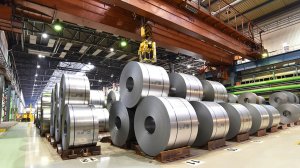Greater collaboration needed in steel supply chain




RELIABLE ROLLOUT? The security of steel supply is a key concern for downstream merchants and fabricators
Photo by Adobe
PAOLO TRINCHERO Large companies with big overheads have struggled most, while smaller companies were more agile and adaptable
NICOLETTE SKJOLDHAMMER There is huge potential for local steel companies in exports
To ensure security of steel supply, the South African Institute for Steel Construction (SAISC) is calling for greater collaboration among all players in the local steel supply chain, from upstream producers to downstream merchants.
Local steel demand was low before the Covid-19 pandemic, which exacerbated the situation, causing all construction activity to be halted in April and May. Towards the end of May, local steel producer ArcelorMittal South Africa (AMSA) said in a statement that it would fully restart operations only once the demand for steel warranted it.
Consequently, this has left some downstream merchants unable to fulfil orders.
“My biggest concern going forward is security of supply. A number of fabricators have a healthy-looking order book going forward; however, some orders had to be cancelled or postponed because AMSA has not been communicative enough about its state of supply,” SAISC chairperson Nicolette Skjoldhammer tells Engineering News.
She says she would like to see steel mills engage more with the rest of the industry because the risk of not having sufficient input material is a serious concern.
SAISC CEO Paolo Trinchero says downstream players need to feed their requirements to the steel mills to ensure that the mills are aware of the demand.
The South African steel industry has been subjected to some antagonism between the upstream and downstream steel industries since the implementation of safeguard duties in 2017 that were imposed against the downstream industry in support of the upstream industry.
Skjoldhammer acknowledges that the upstream industry must be protected because the downstream industry will suffer without it. However, she believes that the safeguard duties need to be reassessed.
“If AMSA cannot guarantee supply, then downstream merchants need to be given the freedom to source their input materials through competitively priced imports,” she argues.
Reinvigorating Industry
Trinchero believes that the Covid-19 crisis has only exacerbated the challenges of the steel industry prior to the pandemic.
“Job losses, consolidations and business rescues have been happening over the past five years until the pandemic broke out. We expect that the Covid-19 lockdown and global pressures because of the pandemic will probably accelerate some of this industry shrinkage even further,” he laments, noting that the rest of the year will be difficult.
He notes that very large companies with big overheads have struggled most throughout the pandemic so far, while small- to medium-sized companies struggled much less because they are more agile.
Companies that have fared best of all are those that were able to continue their exports and provide work for the essential services sectors.
Trinchero believes that the South African steel industry could use the pandemic as an opportunity to engage in more transparent discussions about how to remove obstacles that prevent cohesion and the implementation of strategies to reinvigorate demand.
Skjoldhammer agrees, noting that – similar to a smaller company – South Africa is a smaller country and should, therefore, be more agile.
“If we, as a country, can pivot quickly, we can turn things around. We can use Covid-19 as a cohesive force,” she comments.
Trinchero believes that government could cause a significant increase in steel demand by unlocking a pipeline of infrastructure projects.
“It is necessary for the relevant parties to look into reasons why such infrastructure project pipelines are not being unlocked. Is the business environment conducive to investment? Are there problematic structural issues in the South African economy?”
Moreover, he says there is significant potential for growth in demand from renewable- energy projects in the private sector.
Skjoldhammer emphasises that there is huge potential in exports, adding that total African steel consumption is about 38-million tons a year, of which about 20-million tons a year is imported.
Moreover, she adds that AMSA needs to sell about 1.6-million tons a year to return the business to its “former glory” – which is less than 10% of the African demand for imported steel.
“If South Africa could secure this portion of demand for steel into Africa, it would completely reinvigorate the local industry.”
Skjoldhammer believes that this could become a reality under the pending African Continental Free Trade Area agreement, since the local steel industry is well positioned for export into Africa.
She also believes that current exchange rate conditions are beneficial for export.
“With the weak rand, it actually benefits the local steel industry from an export perspective. We have the raw materials, and if we have the will and the foresight – as well as the support from government and AMSA – we could have a booming steel industry,” Skjoldhammer concludes.
Article Enquiry
Email Article
Save Article
Feedback
To advertise email advertising@creamermedia.co.za or click here
Comments
Press Office
Announcements
What's On
Subscribe to improve your user experience...
Option 1 (equivalent of R125 a month):
Receive a weekly copy of Creamer Media's Engineering News & Mining Weekly magazine
(print copy for those in South Africa and e-magazine for those outside of South Africa)
Receive daily email newsletters
Access to full search results
Access archive of magazine back copies
Access to Projects in Progress
Access to ONE Research Report of your choice in PDF format
Option 2 (equivalent of R375 a month):
All benefits from Option 1
PLUS
Access to Creamer Media's Research Channel Africa for ALL Research Reports, in PDF format, on various industrial and mining sectors
including Electricity; Water; Energy Transition; Hydrogen; Roads, Rail and Ports; Coal; Gold; Platinum; Battery Metals; etc.
Already a subscriber?
Forgotten your password?
Receive weekly copy of Creamer Media's Engineering News & Mining Weekly magazine (print copy for those in South Africa and e-magazine for those outside of South Africa)
➕
Recieve daily email newsletters
➕
Access to full search results
➕
Access archive of magazine back copies
➕
Access to Projects in Progress
➕
Access to ONE Research Report of your choice in PDF format
RESEARCH CHANNEL AFRICA
R4500 (equivalent of R375 a month)
SUBSCRIBEAll benefits from Option 1
➕
Access to Creamer Media's Research Channel Africa for ALL Research Reports on various industrial and mining sectors, in PDF format, including on:
Electricity
➕
Water
➕
Energy Transition
➕
Hydrogen
➕
Roads, Rail and Ports
➕
Coal
➕
Gold
➕
Platinum
➕
Battery Metals
➕
etc.
Receive all benefits from Option 1 or Option 2 delivered to numerous people at your company
➕
Multiple User names and Passwords for simultaneous log-ins
➕
Intranet integration access to all in your organisation

















